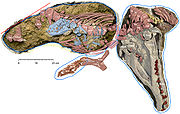
Maiacetus
Encyclopedia
Maiacetus is a genus of early middle Eocene
(ca. 47.5 mya) cetacea
n from Pakistan
.

 The genus contains a single species Maiacetus inuus, first described in 2009 on the basis of two specimens, including a specimen which has been interpreted as a pregnant female and its fetus
The genus contains a single species Maiacetus inuus, first described in 2009 on the basis of two specimens, including a specimen which has been interpreted as a pregnant female and its fetus
. This represents the first description of a fetal skeleton of an archaeocete
. The position of the fetus (head-first) suggests that these whales gave birth on land. Whales generally give birth tail first, while all land mammals give birth head first. That the Maiacetus should give birth on land is not so implausible because this whale is semiaquatic or amphibious. Maiacetus represents the transition of land mammals back to the oceans where these animals were living on the land-sea interface and going back and forth.
However, J. G. M. Thewissen, discoverer of Ambulocetus
, has questioned these conclusions, suggesting that the smaller skeleton could be a partially digested meal. Even if the small skeleton is a fetus, Thewissen writes that it may not have been preserved in its normal in-vivo position.
This species is medium-sized with a skeleton 2.6 m in length and an estimated weight of 280–390 kg.
Eocene
The Eocene Epoch, lasting from about 56 to 34 million years ago , is a major division of the geologic timescale and the second epoch of the Paleogene Period in the Cenozoic Era. The Eocene spans the time from the end of the Palaeocene Epoch to the beginning of the Oligocene Epoch. The start of the...
(ca. 47.5 mya) cetacea
Cetacea
The order Cetacea includes the marine mammals commonly known as whales, dolphins, and porpoises. Cetus is Latin and is used in biological names to mean "whale"; its original meaning, "large sea animal", was more general. It comes from Ancient Greek , meaning "whale" or "any huge fish or sea...
n from Pakistan
Pakistan
Pakistan , officially the Islamic Republic of Pakistan is a sovereign state in South Asia. It has a coastline along the Arabian Sea and the Gulf of Oman in the south and is bordered by Afghanistan and Iran in the west, India in the east and China in the far northeast. In the north, Tajikistan...
.
Paleobiology


Fetus
A fetus is a developing mammal or other viviparous vertebrate after the embryonic stage and before birth.In humans, the fetal stage of prenatal development starts at the beginning of the 11th week in gestational age, which is the 9th week after fertilization.-Etymology and spelling variations:The...
. This represents the first description of a fetal skeleton of an archaeocete
Archaeoceti
Archaeocetes, or "ancient whales", are a paraphyletic group of cetaceans that gave rise to the modern cetaceans.The archaeocetes were once thought to have evolved from the mesonychids, based on dental characteristics...
. The position of the fetus (head-first) suggests that these whales gave birth on land. Whales generally give birth tail first, while all land mammals give birth head first. That the Maiacetus should give birth on land is not so implausible because this whale is semiaquatic or amphibious. Maiacetus represents the transition of land mammals back to the oceans where these animals were living on the land-sea interface and going back and forth.
However, J. G. M. Thewissen, discoverer of Ambulocetus
Ambulocetus
Ambulocetus was an early cetacean that could walk as well as swim. It lived during early Eocene some 50-49 million years ago. It is a transitional fossil that shows how whales evolved from land-living mammals. The Ambulocetus fossils were found in Pakistan by anthropologist Johannes Thewissen...
, has questioned these conclusions, suggesting that the smaller skeleton could be a partially digested meal. Even if the small skeleton is a fetus, Thewissen writes that it may not have been preserved in its normal in-vivo position.
This species is medium-sized with a skeleton 2.6 m in length and an estimated weight of 280–390 kg.

